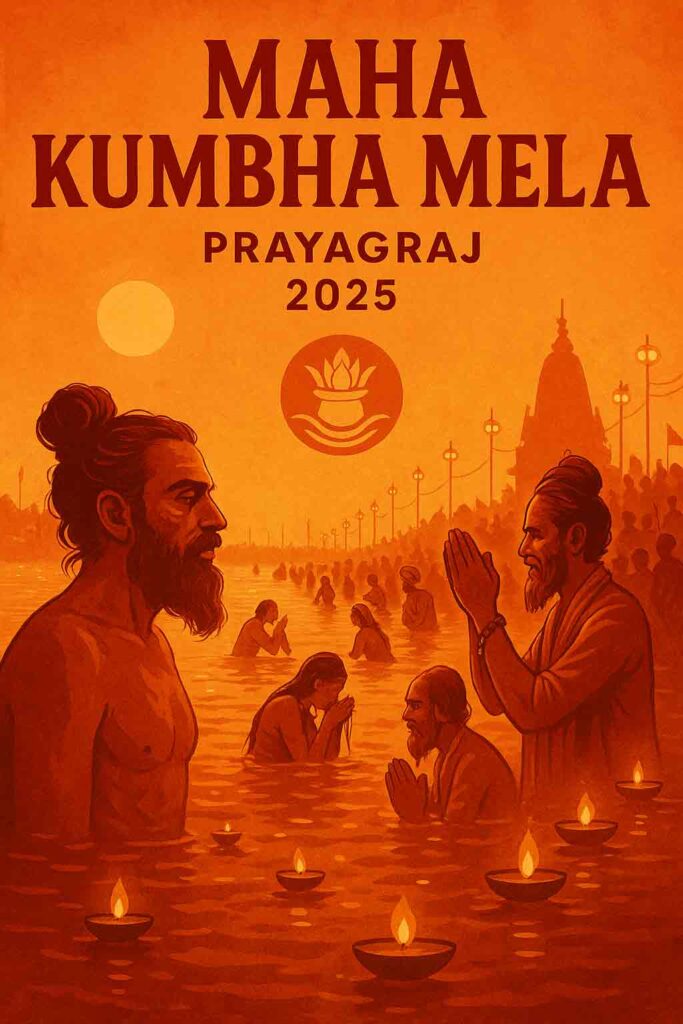Maha Kumbha Mela (Every 12 years)
A grand Hindu pilgrimage and ritual bathing at sacred rivers.

The Maha Kumbh Mela is one of the world’s largest and most spiritually significant religious gatherings, deeply rooted in the ancient traditions of Hinduism. Held once every twelve years, it takes place at one of four sacred locations in India — Prayagraj (Allahabad), Haridwar, Ujjain, and Nashik — which are situated along the banks of the holy rivers Ganga, Yamuna, Godavari, and Shipra respectively. Among these, the Maha Kumbh at Prayagraj is considered the most auspicious, as it marks the confluence of three sacred rivers: the Ganga, Yamuna, and the mythical Saraswati. The scale, devotion, and faith witnessed at the Maha Kumbh Mela have earned it global recognition, even being listed by UNESCO as an Intangible Cultural Heritage of Humanity.
The origins of the Kumbh Mela are steeped in mythology. According to Hindu belief, during the churning of the cosmic ocean, known as the Samudra Manthan, gods and demons struggled for the divine nectar of immortality, or amrit. As the story goes, drops of this nectar fell at four earthly locations — the present-day sites of the Kumbh Melas. Thus, these places became sanctified, and bathing in their holy rivers during the auspicious period of the Mela is believed to cleanse devotees of their sins and lead them toward moksha, or liberation from the cycle of rebirth. The word “Kumbh” itself means a pitcher or pot, symbolizing the vessel that carried the nectar of immortality.
The Maha Kumbh Mela is not just a religious festival; it is a grand spectacle of faith, devotion, and humanity. Millions of pilgrims, saints, and ascetics—some living in remote Himalayan caves—descend upon the sacred site to participate in rituals, prayers, and spiritual discussions. The most significant ritual is the Shahi Snan or Royal Bath, when sadhus and devotees take a holy dip in the river at specific auspicious times determined by planetary alignments.
The sight of Naga Sadhus—ash-smeared ascetics clad in little or no clothing, their bodies symbolizing renunciation of the material world—marching in vibrant processions is one of the most iconic images of the Mela. Alongside, thousands of saints and spiritual leaders set up akharas (religious camps), where they deliver sermons, engage in philosophical debates, and offer blessings to pilgrims.
Beyond its spiritual essence, the Maha Kumbh Mela also serves as a living example of India’s cultural and social unity. People from all walks of life, regardless of caste, creed, gender, or social status, come together in a spirit of equality and shared devotion. The temporary city that arises during the event is a marvel of organization and planning. Spread across thousands of hectares, it includes tent accommodations, sanitation facilities, hospitals, police stations, and food distribution centers. Despite the challenges of managing such vast crowds—often exceeding 50 million people in a single day—the event typically runs smoothly, a testament to India’s capacity for coordination and collective discipline rooted in faith.
In modern times, the Maha Kumbh Mela has also attracted international attention. Scholars, photographers, and tourists from around the world visit to witness this extraordinary convergence of spirituality and humanity. Governments and technology companies have introduced innovations like digital crowd management, drone surveillance, mobile apps, and online registration systems to enhance safety and accessibility. The event thus stands as a unique blend of ancient tradition and modern governance.
Ultimately, the Maha Kumbh Mela transcends its physical dimensions to become a profound spiritual experience. It symbolizes the eternal quest of humankind for purity, truth, and liberation. For the devout Hindu, a single dip in the sacred waters during the Mela holds the promise of salvation. But even for the observer, it offers a glimpse into the soul of India—its resilience, faith, and timeless philosophy that views life as a journey toward the divine. The Maha Kumbh Mela, therefore, is not merely a festival; it is a celebration of life, faith, and the eternal rhythm of the cosmos.
